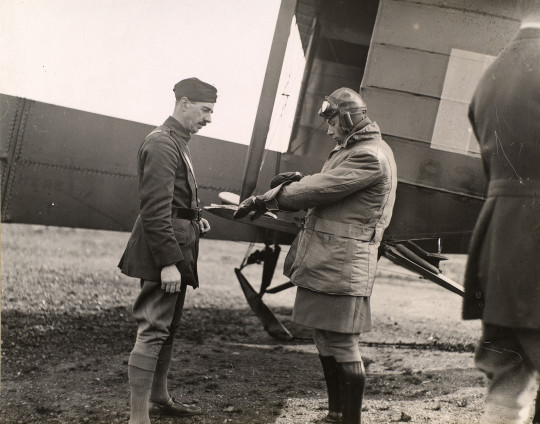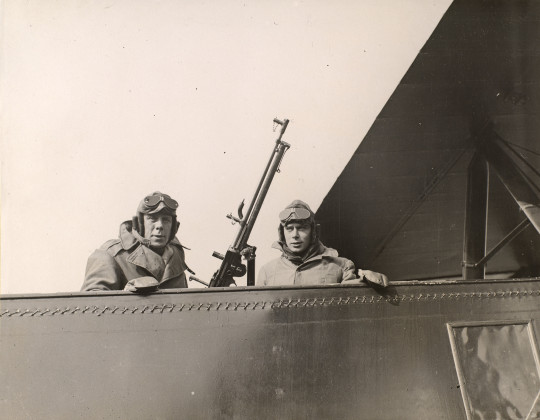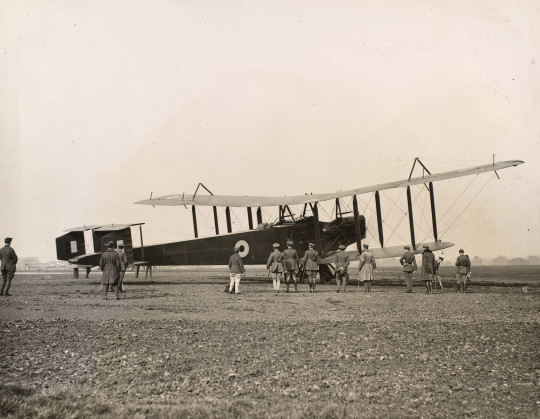#handley page o/400
Explore tagged Tumblr posts
Photo




Prince Albert, as he was known at the time, and his friend Major Louis Greig getting prepared to fly to France. These photographs were taken in 1918 at Hendon (formerly a civilian flying school, which was commandeered by the War Office in 1916). Bertie gained his RAF pilot wings on July 31st 1919, becoming the first member of the British Royal Family to qualify - and to achieve this despite actually having a phobia of flying & heights was in itself rather courageous! I do also think he looks somewhat anxious, all cocooned in that big padded coat, gauntlets and helmet. Still adorable, though :)
Fourth photo: they’re just about visible in the cockpit, but the aircraft nerd in me mostly wanted to show off that biplane bomber, a Handley Page O/400, oh my!
#brave king bertie#george vi#king george vi#king bertie#prince albert#louis greig#the british royal family#the british monarchy#god save the king#biplane#handley page o/400#vintage airplane#ww1 planes#royal air force#albert duke of york
18 notes
·
View notes
Text
Markgraf Volksfestung A - "The People's Doomsday Device"

Role: Strategic Bomber Served With: Kingdom of Sopwith First Flight: 1596 Strengths: Bombload, Turrets Weaknesses: Expensive to Run Inspiration: Handley-Page o/400 (1916)
Description:
Among the grimmest of the Kingdom of Sopwith’s policies was the Volksfestung Program, where villages were given responsibility to maintain, train on, and if needed fly a heavy bomber. The industrial outlay involved was immense, each aircraft requiring enough engines and guns for two scouts. Some Volksfestungs were even rebuilt as ‘Dammbrechers’, carrying a single 750kg bomb.
To build enough aircraft to equip a full bombing force and then hold them completely in reserve involved bankrupting the previously-rich Kingdom of Sopwith entirely and levying punitive taxes at all levels of society.
When the time came, these bombers had somewhere to come back to. Bombers, fewer each day, returned to the villages, loved ones snatching moments as they were refuelled and rearmed and taken aloft again. Eventually no bombers came back. The pilots and aircraft had scattered across the continent, preferring to risk the kindness of their victims to having to fly one more gas mission.
5 notes
·
View notes
Video
mitch043HandleyPagebomber by Central Repository for Aviation Photos
2 notes
·
View notes
Photo










Handley Page Type O
#Handley Page#Type O/100#Type O/400#Bomber#Airplane#Aircraft#Pulp#Dieselpunk#Weird War#WW1#The Great War
203 notes
·
View notes
Text
Ronnie Bell Following
Martin MB-1
Martin MB-1, front right three-quarter view, Army Air Service serial number 39059, with McCook Field project number P104. (This aircraft was later modified to have a third engine in the nose.) The Martin MB-1 was an American large biplane bomber designed and built by the Glenn L. Martin Company for the United States Army Air Service in 1918. It was the first purpose-built bomber produced by the United States.
In 1921 Martin produced its KG.1 variant of the MB-1, with ten purchased by the Navy as torpedo bombers under the designation MBT. After two were purchased, the designation was changed to Martin MT.
In response to a requirement from the Air Service for a bomber that was superior to the Handley Page O/400. Martin proposed the MB-1 and were rewarded with an initial production contract for six aircraft. The MB-1 was a conventional biplane design with twin fins and rudders mounted above the tail plane and a fixed tailwheel landing gear with four-wheel main gear. Powered by two 400 hp (298 kW) Liberty 12A engines, it had room for a crew of three in open cockpits.
Initial delivery to the Air Service was in October 1918, with the aircraft designated GMB for Glenn Martin Bomber. The first four produced were configured as observation aircraft, and the next two as bombers. Four others were produced before the end of World War I cancelled all remaining war contracts. The last three aircraft each were configured experimentally, with separate designations: GMT (Glenn Martin Transcontinental), a long-range version with a 1,500 mi (2,400 km) range; GMC (Glen Martin Cannon) with a nose-mounted 37 mm (1.46 in) cannon; and GMP (Glenn Martin Passenger) as an enclosed ten-passenger transport. The GMP was later redesignated T-1. Six surviving aircraft were later modified and used by the United States Postal Service as mail carriers. The design was the basis for the Martin MB-2, which had a greater load capability but was slower and less manoeuvrable.
Ten aircraft were used by the United States Navy from 1922 under the designations MBT and MT and were used as torpedo bombers, two by the Navy and eight by Marine Corps squadron VF-2M. On 5 October 1923, the Marine Corps entered an MT, serial number A-5720, in the National Air Races in St. Louis. The aircraft raced with the racing number 58, placing third on the 160 nautical miles; 190 miles (300 km) course.
They were used in the West Virginian Coal Wars, notably in the Battle of Blair Mountain, as aerial observers sent in by President Warren Harding. One aircraft was lost, crashing on the return flight, with the loss of three crewmen.
Via Flickr
7 notes
·
View notes
Text
Ligescourt Aerodrome OTD Aug 29 1918
Aug 29 1918 OTD At the French Ligescourt Aerodrome, war photographer David McLellan takes these photos of a clayton tractor towing a Handley Page O/400 bomber of No. 207 Squadron.

IWM Q 12104

IWM Q 9970 - Major John Simon RAF inspecting the Handley Page 0/400 heavy bomber

IWM Q 12105

IWM Q 12107

IWM Q 10376 - Air mechanics of No. 207 Squadron RAF moving a big bomb by railway to load it on to a night bombing aeroplane, bomb reads: "A little hell pie from the RAF.”

IWM Q 9971
29 August 1918-08-29
34 notes
·
View notes
Photo

Two Handley Page O/400 Heavy Bombers on the R. N. A. S. Aerodrome, near Dunkirk 20 April 1918. (IWM)
12 notes
·
View notes
Video
mitch045photoplane1919 by Central Repository for Aviation Photos
2 notes
·
View notes
Photo

Aug 29 1918 IWM (Q 12107) "A Clayton tractor towing a Handley Page O/400 bomber of No. 207 Squadron at Ligescourt Aerodrome" August 29 1918 by McLellan, David (Second Lieutenant) (Photographer) https://t.co/dVg88KVUEl https://t.co/H3aUQHeUJn http://twitter.com/ThisDayInWWI/status/1167149921688064000
11 notes
·
View notes
Photo

Aug 29 1918 "A Clayton tractor towing a Handley Page O/400 bomber of No. 207 Squadron at Ligescourt Aerodrome" https://t.co/dVg88KEjfL https://t.co/KIMILiF8qW http://twitter.com/ThisDayInWWI/status/1034815795568697345
21 notes
·
View notes
Photo




Apr 20 1918 "Two Handley Page O/400 bombers on the aerodrome near Dunkirk"
IWM (Q 12035)
IWM (Q 12037)
IWM (Q 12034)
IWM (Q 12038)
137 notes
·
View notes
Video
AL-61B Album Image _00092 by SDASM Archives Via Flickr: Images from an Album (AL-61B) donated by Leisure World Aerospace Club showing misc aircraft. Repository: San Diego Air and Space Museum Archive
0 notes
Photo

THE ROYAL NAVAL AIR SERVICE (RNAS) 1914-1918
A Handley Page O/400 bomber of No. 207 Squadron being moved using a Clayton tractor at Ligescourt, 29 August 1918. (IWM)
7 notes
·
View notes


